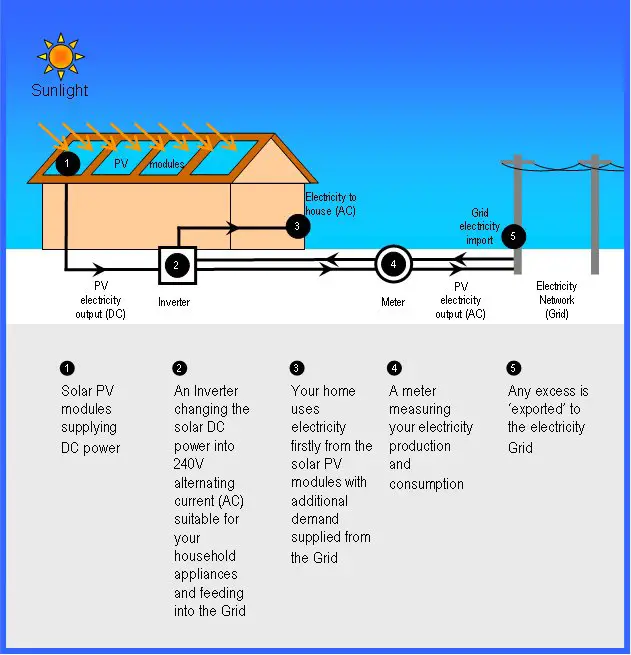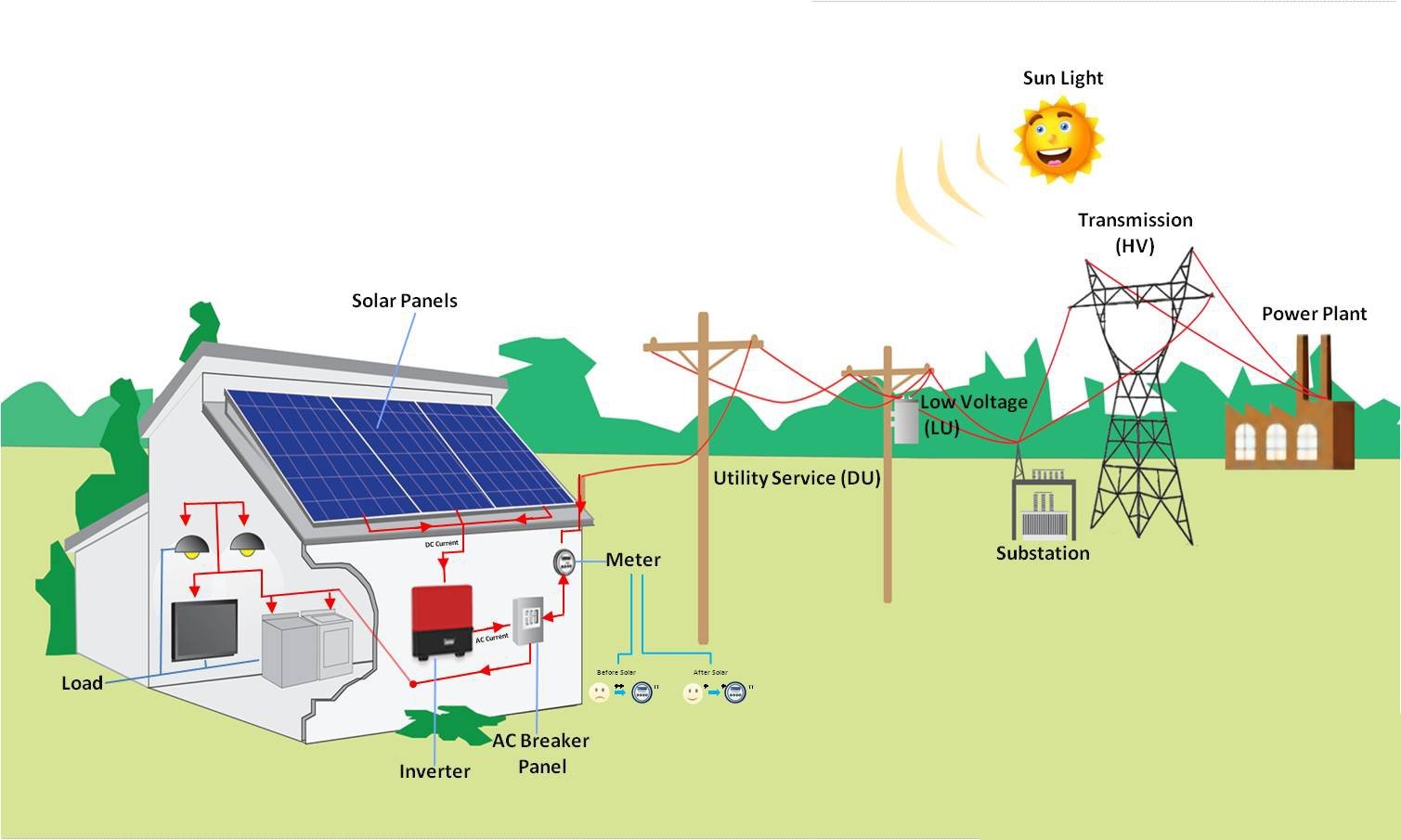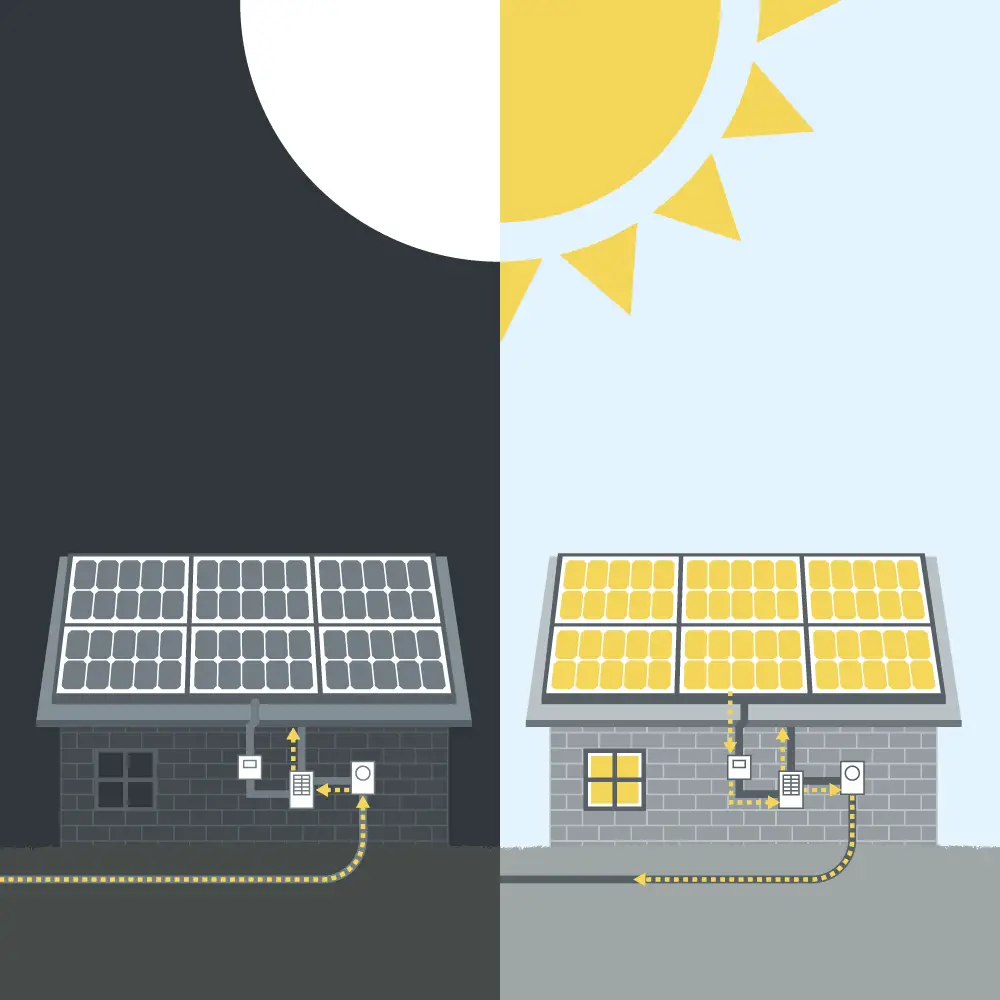Net Metering And Grid
On a sunny day, itâs common for solar homes to send excess electricity into the grid in the middle of the day when power generation is at its peak. How you receive credit from your utility company is dependent on a policy called net metering.
Adequately describing net metering requires an article by itself – which you can read here – but the graphs below give you a quick idea of what it looks like over the course of a day.
In the first graph, you can see that when the sun isnât shining, a solar home will pull power from the grid, and tend to generate excess electricity in the middle of the day.
With net metering, you get full credit for the extra electricity sent into the grid, which is used to offset any power that you need to draw from the grid at night or when solar power generation is low.
Mount The Solar Panels
A lot of panels come with mounting brackets which you can easily attach to your platforms, especially if the platforms are wood. For steel platforms or roofs, however, you might need a better drill, and be careful with that roof too. However, if the panels do not come pre-fastened with brackets, you might want to contact your dealer and inquire whether the bracket is provided or where to put one.
For brackets though, angled ones are the most ideal, secure the front feet first. Make sure they are squared and centered before being secured in place with screws or other materials which you have.
Solar Photovoltaic Costs Considerations In Bc
The cost of installing solar PV systems has declined steadily over the last decade as a result of technology improvements and more efficient systems yielding a higher power output.
In B.C., a 1 kW solar PV system, south facing and tilted with no shading, will generate about 1,200 kWh per year or about 30,000 kWh over its 25 year lifetime. This is taking into account an industry average solar panel efficiency degradation rate of 0.5% per year.
At a turnkey installation cost of about $3,000, it would take you over 25 years to recoup your investment at today’s average electricity rates.
In remote locations where there is no grid to tie into for power, off-grid solar PV systems can be used to store power in batteries which can be used throughout the day or even at night. In B.C., off-grid systems make for a sound investment when installed in locations where alternative power sources such as diesel generators are required.
Batteries are obviously an added cost to an off-grid system and, depending on the type of batteries used, they require regular maintenance and/or replacement during the system’s lifecycle.
Also Check: What Is The Carbon Footprint Of Making A Solar Panel
What Does It Mean To Wire Solar Panels In Series
Just like a battery, solar panels have two terminals: one positive and one negative.
When you connect the positive terminal of one panel to the negative terminal of another panel, you create a series connection. When you connect two or more solar panels like this, it becomes a PV source circuit.
Solar panels are wired in series when you connect the positive terminal of one panel to the negative terminal of another.
When solar panels are wired in series, the voltage of the panels adds together, but the amperage remains the same. So, if you connect two solar panels with a rated voltage of 40 volts and a rated amperage of 5 amps in series, the voltage of the series would be 80 volts, while the amperage would remain at 5 amps.
Putting panels in series makes it so the voltage of the array increases. This is important, because a solar power system needs to operate at a certain voltage in order for the inverter to work properly.
So, you connect your solar panels in series to meet the operating voltage window requirements of your inverter.
Select And Charge The Battery

A major hiccup with solar power is that it doesnt provide electricity when the sun goes down. However, you can easily crack this problem by using a battery. A lead-acid or a lithium-ion battery stores solar power generated during the daytime and discharges it at night. This provides a steady supply of energy, provided you have selected the optimum battery storage capacity. You will need a power controller to monitor your batterys charging. These come between the panels and the battery. Such controllers are typically fitted with a small LED light that announces the charging state of the battery, and it adjusts the power that flows into the battery.
Read Also: How To Get The Best Solar Deal
Do Your Research On The Practicality Of Going Solar In Bc
Solar energy is an affordable alternative energy that can be used to help heat and power your home or business. However, there are some important considerations around the use of both solar photovoltaic and solar thermal systems in British Columbia that you should be aware of.
While the cost of installing a solar photovoltaic system for electricity generation has dropped dramatically in recent years, for homeowners in B.C. connected to the BC Hydro electrical system, it would take at least 20 years to recoup the investment at today’s average electricity rates. However, in remote locations where there is no grid to tie into for power, off-grid solar PV systems can be used to store power in batteries and can make for a sound investment.
In Canada, solar thermal systems are used mostly for domestic water heating rather than for primary space heating. In our climate conditions, other fuel-source options may be more economical for primary space heating than a solar thermal system.
Avoid Common Mistakes People Make When Installing Solar
Solar panels effectively produce electricity for a period of 25 years from the day of installation. However, solar panels should be installed properly to churn out the benefits in the long run.
There are 5 major common mistakes generally Solar Installers happen.
Don’t Miss: What Solid Food To Introduce To Baby First
How Does Net Metering Work
Net metering works to send any extra energy that your solar panel system produces back to the power grid, and you are credited for that energy at a 1 to 1 ratio . Those credits can be used on future electric bills. Note that some utility companies do not offer net metering. Overall, this is a great incentive for solar energy use.
Connect Charge Controller To Your Battery
- PWM-regulators are cheap, but they are suitable only when the voltage of panels is slightly higher than the voltage of a battery. They simply cut down the voltage to the level of the battery.
- MPPT-controllers are more sophisticated and expensive. They convert extra voltage to electricity, so you barely lose any of the generated energy.
Recommended Reading: How To Get Certified In Solar Panel Installation
How Many Watts Do You Use
When looking at your utility bill, you should be able to see kilowatt-hours . KWH for homes can vary greatly depending on location. A home in the south is more likely to draw massive amounts of energy from air conditioner units.
Finding the average daily energy usage will help you calculate your solar needs. Once you have your usage you can look at how much wattage youll need to be able to run everything.
By Step Guide On How To Set Up Solar Power At Home
Clean energy is gaining ground rapidly just when greenhouse gases and carbon emissions are immensely hurting our ecosystem. Worldwide, two-thirds of solar power capacity have been installed since 2011. Fortunately, India has kept pace with the rapid development of clean solar power. Reports indicate that solar power generation in India increased by a whopping 86% in 2017.
It is now ideal to use solar power not only in commercial units but also for residential ones. The costs of installing a solar power unit have steadily dropped, but you can always try the DIY option to keep it within your budget. Initiatives like scoop.solar are helping professionals with solar photo-voltaic installations. However, you can save money by setting up a solar PV system yourself by reading this simple guide to set up solar power. Here is an in-depth look at how you can build and install a solar power unit for your home:
Don’t Miss: How Does The Solar Credit Work
Wiring Solar Panels When Using A String Inverter
String inverters have a rated voltage window that they need from the solar panels in order to operate. It also has a rated current that the inverter needs to function properly.
String inverters have maximum power point trackers in them that can vary the current and voltage to produce the maximum amount of power possible.
In most crystalline solar panels, the open circuit voltage is around 40 Volts. Most string inverters have an operational voltage window between 300 and 500 volts. This would mean that when designing a system, you could have between 8 and 12 panels in a series.
Any more than that would exceed the maximum voltage the inverter could handle.
The thing is, most solar panel systems are larger than 12 panels. So, in order to have more panels in the system, you could wire another series of panels, and connect those series in parallel. This allows you to have the right number of panels to meet your homes energy needs, without exceeding the limits of your inverter.
Can You Add More Solar Panels To Your Existing System

Going with a full installation from the start is always best when installing a residential solar system. Using a solar calculator helps estimate your solar system costs and power needs in order to accurately determine how many panels you should have in your system.
However, if you were limited with your budget, or underestimated your future power needs when you installed your PV panels, you could consider adding more panels to your existing system.
If you are thinking about expanding your solar PV system in the future, you should design your system with that in mind. In order to accommodate more panels in the future, you should have an oversized inverter.
Don’t Miss: Is Solid State Drive Better
Here Is The Simple Steps To Install Solar Panels
Step 1: Solar Panel Installation Made Easy
Step 2: Assembly of Solar Panels
Step 3: Electrical Wiring
Step 4: Connection between Solar Panel and Solar Inverter
Step 5: Connection between Solar Inverter and Solar Battery
Step 6: Connection between Solar Inverter and Grid
Step 7: Start Solar Inverter through Solar Panel & Grid
Step 8: See Solar Panel Installation Video
Key Electrical Terms To Understand For Solar Panel Wiring
In order to understand the rules of solar panel wiring, it is necessary to understand a few key electrical termsparticularly voltage, current, and powerand how they relate to each other.To understand these concepts, a helpful analogy is to think of electricity like water in a tank. To expand the analogy, having a higher water level is like having a higher voltage there is more potential for something to happen , as illustrated below.
You May Like: How Big Does My Solar System Need To Be
Home Solar Panels And The Grid
When a homeowner decides to add solar panels to their home, in most cases they will choose to be grid connected. This means that the home can get electricity both from its solar panels and the electric grid.
This is important because solar energy is intermittent: it stops working when the sun sets. When this happens, a grid-connected solar home will use electricity from the grid to meet its needs. This process happens automatically and is seamless to the homeowner.
In the other case, when solar panels generate more electricity than a grid-connected home needs, it will send its extra electricity into the grid. That solar electricity will then get used by the neighborhood. No electricity gets wasted.
Connecting Charge Controller To Battery
Once the voltage has been stabilized by the charge controller, it can now be channeled to the battery for storage. You can set the desired voltage on the charge controller depending on the capacity of the battery. If it is the usual 12 Volt battery, set the controller to 13.8volts. You can use one or more batteries if you have them.
In the event you have more than one battery, connect them in parallel. The same voltage of 13.8 from the charge controller can charge all the battery connected in parallel. Same applies to two or more solar panels.
Don’t Miss: How Much Does It Cost For Solar Panels
Set Up The Grounding For The Array
In order for the solar panel arrays to be safe for human hands to touch without being grounded, you will need proper grounding for them. To do this, bury a grounding rod with about six inches of its body sticking out. You can do this either on a wood surface or on the ground.
Once that is done, run a copper grounding wire from the rod to the fuse box and from the solar panels to the fuse box. The panels should now be grounded safely.
Solar Benefits For Non
Solar panel systems offer a common benefit, regardless of their size: they generate electricity from sunlight, reducing the amount of electricity you must pay your utility company for each month. Solar power also lowers the environmental footprint of your home, especially if you live in a region where most of the grid electricity comes from fossil fuels.
Homeowners get a few extra benefits when they install a traditional solar system, including:
- Their property becomes more valuable, and many states don’t charge increased property taxes for the portion of home value that corresponds to solar panels.
- Homeowners also qualify for the 26% federal solar tax credit as well as any additional incentives from state governments or utility companies.
- There are permitting and grid connection requirements to meet, but once the solar PV system starts operating, it provides electricity for decades with minimal maintenance.
While mini solar panel systems may not be eligible for these perks, they have their benefits compared with rooftop systems. For example, they are much easier to install, with no permitting involved, and any maintenance is much simpler. Small-scale solar systems also have a lower price, and they are easily relocated.
Read Also: What’s Bad About Solar Energy
How Do Solar Panels Wired In Series Compare To Solar Panels Wired In Parallel
A charge controller is a determining factor when it comes to solar panel wiring. Maximum Power Point Tracking charge controllers are for wiring solar panels in a series, where Pulse Width Modulation charge controllers are used to wire solar panels in parallel.
To understand how wiring in series works in comparison to how parallel wiring works, lets think for a moment about how Christmas lights used to work.
If a bulb burned out, came loose from its socket or broke, the entire string wouldnt light up. This was because the lights were wired in a series. You would have to locate the problem bulb and replace it or reseat it to get the string of lights to work again.
Today, most Christmas lights feature a form of parallel wiring that allows for strings of lights to stay lit even when there is one troublemaker in the string.
Circuits wired in series work the same way for solar panels.
If there is a problem with the connection of one panel in a series, the entire circuit fails. Meanwhile, one defective panel or loose wire in a parallel circuit will not impact the production of the rest of the solar panels.
In practice, how solar panels are wired today depends on the type of inverter that is being used.
Find out how much solar panels can save you annually
Process Of How To Install Solar Panels

Standard solar installations take no longer than a day or two, and prior to the installation, the MCS-certified installer will have carried out a comprehensive survey to find out all the details. The installation team comprises 2 or more roofers and an electrician for the wiring.
1. Erect the scaffolding
This is imperative for the safety of the installation team. Its worth checking that the cost for installing the scaffolding is included, and that theres enough room outside your house for the scaffolding tower.
2. Attach roof anchors
The roof anchors are there to hold the frame for the solar panels, and the type of anchor used will be determined by the type of roof tile fitted. The installation team will start by lifting some of the tiles on your roof and fixing the roof anchors to the rafters. The installer should have already gone into the loft during the survey to check that the rafters and the roof are suitable for installing solar panels.
3. Attach the frame
The aluminium frame attach to the anchors, which run vertically and horizontally across the roof.
4. Install the solar panels
Finally, its time to attach the panels onto the frame. The panels clamp loosely to the frame, then theyre tightened once the installer has positioned them in their optimal angle.
5. Solar panel wiring
This is where youll need a certified solar installation team. The panels usually come prewired from the manufacturer, but they still need to be connected to an inverter.
6. Final checks
Recommended Reading: How To Start A Solar Farm Business
